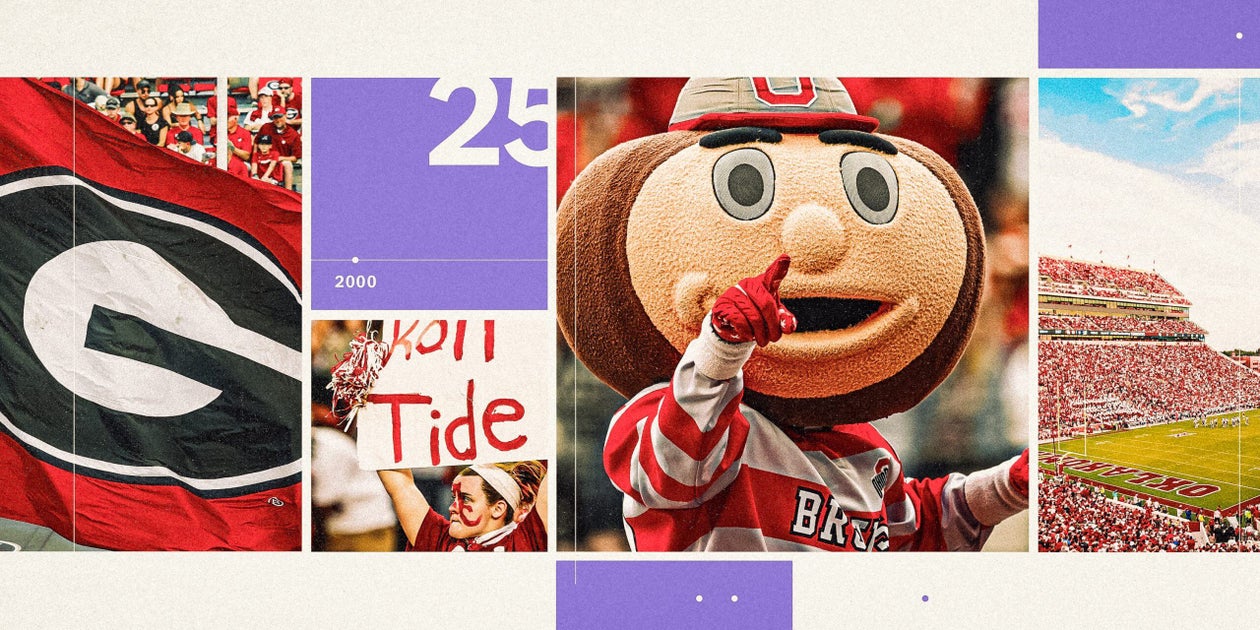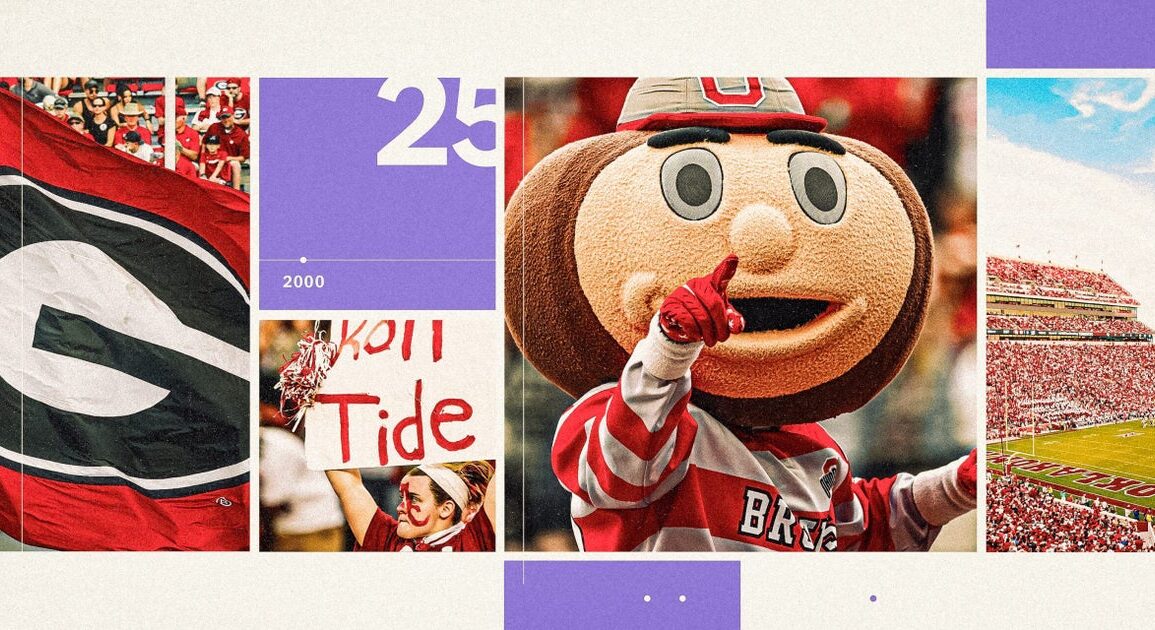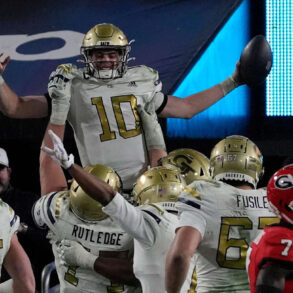
Editor’s note: All week, The Athletic has been looking back at the best of the first 25 years of the 2000s in college football. Also read the top 25 teams, top 25 players, top 25 coaches and top 25 games.
We as college football fans often suffer from short memories. This exercise will serve as a nice reminder that most programs have not been exactly as good or exactly as bad as they are right now over the course of 25 years.
Advertisement
The factors I considered when ranking the top programs of the 2000s so far: Overall winning percentage, BCS or New Year’s Six bowl appearances (including last year’s first-round CFP games), national championships, conference championships*, wins against ranked opponents (via Stathead), percentage of total weeks spent in the AP Top 25 and top 10 (via College Poll Archive) and, as a counterbalance, their number of losing seasons.
*Because every league but the SEC had co-champions at some point this century, I used each league’s automatic BCS/CFP entrant to ensure only one champion per year in each conference.
Michigan State’s overall numbers aren’t great. But from 2010-17, Mark Dantonio led the Spartans to six double-digit-win seasons, including a Rose Bowl win in 2013 and CFP berth in 2015. Then came an 11-win season and New Year’s Six bowl win in 2021.
They beat out West Virginia, Louisville, Kansas State and Stanford for the final spot.
Washington’s modest win percentage and eight losing seasons don’t help its case to be included in these rankings. But the Huskies started the century with a No. 3 finish in 2000 and returned to prominence in the 2010s with three consecutive double-digit-win seasons (2016-18) and a Playoff appearance under Chris Petersen, before back-to-back top-10 seasons and a trip to the national title game under Kalen DeBoer in the 2020s.
This is the one program that has had the same coach, Kirk Ferentz, for the entire century. He averaged 8.2 wins over that span (not including 2020). The Hawkeyes reached a bowl game in all but three seasons, including two Orange Bowls (2002 and ’09) and a Rose Bowl (2015), and have finished a season ranked 11 times.
Utah, then a member of the Mountain West, posted undefeated seasons in 2004 (under Urban Meyer) and 2008 (under Kyle Whittingham) before moving up to the Pac-12 in 2011. Whittingham has led the Utes to four double-digit-win seasons since then, with Pac-12 titles in 2021 and ’22, but they’re more often an eight- or nine-win team.
Mike Gundy’s Cowboys posted eight double-digit-win seasons from 2010-23 and have finished as a ranked team 10 times since he took over in 2005, more than the school registered in the 20th century. They more than held their own against Top 25 competition, too.
Their two glaring holes are just one Big 12 title (in 2011, when they came up just short of the BCS title game) and a 6-18 record against rival Oklahoma.
Figuring out where to rank Boise State was by far my biggest challenge. The Broncos’ .808 winning percentage and zero losing seasons, even in Group of 5 leagues, are remarkable, as are their four Fiesta Bowl appearances (including two wins). But their relatively few ranked wins (18) are a reminder of the level of competition.
Gary Patterson spent the first dozen years of the century racking up double-digit wins in Conference USA and the Mountain West, culminating in an undefeated season with a Rose Bowl victory in 2010. The Frogs have been less consistent in the Big 12, but they have still won at least 11 games four times since making the jump, most notably their trip to the CFP championship game in 2022.
Virginia Tech under Frank Beamer was one of the nation’s top programs from 2000-11, finishing in the Top 25 all but one season, including five top-10 seasons, and winning four ACC titles from 2004-10. But the Hokies have had only two ranked finishes since then, in 2016 and ’17, and saw their streak of 25 straight winning seasons end in 2018.
Penn State’s century got off to a rough start with four losing seasons in five years under the previously dominant Joe Paterno. He rebounded to win Big Ten titles in 2005 and ’08. More recently, James Franklin has won double-digit games in six of the past nine seasons. But the lack of big wins is glaring — just seven against top-10 foes this century.
Wisconsin was a picture of consistency until recently, winning at least 10 games all but five times from 2005-19 under coaches Barry Alvarez, Bret Bielema, Gary Andersen and Paul Chryst. It went to three straight Rose Bowls from 2010-12. But the Badgers have also never reached the CFP and have just 10 top-10 wins (tied for 28th).
Arguably no program has experienced as many peaks and valleys this century as Auburn. The Tigers enjoyed undefeated seasons in 2004 and 2010, winning the national championship in the latter, and reached another national title game in 2013. But they’ve also won eight games or fewer in 15 of 25 seasons, had a 3-9 debacle in 2012 and have gone 5-7 or 6-7 each of the past four years.
Miami’s dominance at the start of the century in its final years in the Big East — it went 46-4 with four consecutive top-five finishes from 2000-03 — helped The U land in the top 15 despite a largely forgettable two decades since joining the ACC in 2004. The Canes have reached double-digit wins only twice since then, in 2017 and 2024, without winning a conference title — though they still rank in the top 20 in every data point I looked at.
It’s been a tale of two 21st centuries for Notre Dame, which was mediocre for the first dozen seasons (Charlie Weis’s 2005 and ’06 BCS bowls excluded) before transforming under Brian Kelly and Marcus Freeman. Since 2012, the Irish have reached two national title games, played in two other CFPs and hit the 10-win mark nine times.
The late Bobby Bowden reached his last of three consecutive BCS title games in 2000 before falling off. But Jimbo Fisher’s run of six double-digit-win seasons in seven years from 2010-16 (most notably winning the 2013 BCS title) coupled with Mike Norvell’s pair in 2022 and ’23 more than compensated for the Noles’ five losing seasons since 2018.
Michigan went through some bleak years under Rich Rodriguez (2008-10) and Brady Hoke (2011-14). But before that, Lloyd Carr led the Wolverines to three Rose Bowls in four years. And then came Jim Harbaugh (2015-23), who delivered six double-digit-win seasons, culminating in a 37-3 run over his last three seasons and national title in 2023.
This one surprised me, given the Gators peaked in 2009 under Urban Meyer. But believe it or not, five coaches — Steve Spurrier (who left in 2001), Meyer, Will Muschamp, Jim McElwain and Dan Millen — notched at least one 10-win season. Meyer won two national titles in three years and Mullen went to three consecutive New Year’s Six bowls.
Texas enjoyed a dominant first decade under Mack Brown, winning double-digit games every year from 2001-09, earning one BCS title and playing for another. Then the program went in the tank for most of the next dozen years, before Steve Sarkisian led the Longhorns to consecutive CFP semifinals.
USC appearing in the top 10 is a testament to just how dominant the Trojans were under Pete Carroll from 2002-08, when it went 82-9, won six consecutive Pac-12 titles and two national crowns (one shared). While it feels like USC has been struggling ever since, it has added four more double-digit-win seasons and three New Year’s Six bowl bids.
Some may scoff at ranking Oregon this high without having won a national championship, but every other data point is that of an elite program. The Ducks’ 182 weeks spent in the AP top 10 are higher than the likes of LSU, Clemson and Texas, among others. And they’ve been to more BCS/NY6 bowls than USC, Michigan and Notre Dame.
Clemson was admittedly nothing special for the century’s first 11 seasons, peaking at nine wins, and even then only four times. Then Dabo Swinney found his groove, and the Tigers won fewer than 10 games just once over the past 14 seasons. The program’s rise aligned with the start of the CFP, which it has reached seven times since 2015, with national championships in 2016 and 2018.
While it may seem like LSU has yo-yoed between peaks and valleys, it’s hard to argue with 13 double-digit-win seasons across four coaches (Saban, Les Miles, Ed Orgeron and Brian Kelly), three of whom won national titles. The Tigers have won a ton of big games, ranking third in both Top 10 and Top 25 wins. A “bad” season has generally been 9-4 or 8-5.
The underappreciated Mark Richt led the Dawgs to double-digit wins in nine of his 15 seasons, then passed the baton to Kirby Smart who promptly took the program to another level. In nine seasons he has a .846 winning percentage and has accounted for three of the program’s five conference championships and both national titles this century.
Oklahoma was even more consistent than Ohio State until suffering two losing seasons over the past three years. No other power program comes close to the Sooners’ 13 conference titles (all in the Big 12). Bob Stoops started the century with a national title before playing for three more, and Lincoln Riley added three consecutive Playoff appearances.
Those six national championships between 2009 and ’20 pretty much say it all, and Alabama played for three others in addition to those. Its winning percentage gets dragged down a bit by a 53-46 start to the century, but Saban’s teams then won at least 11 games in all but one season from 2008-23 — and won 10 in the other one.
Only one program has spent nearly the entire century competing at an elite level – and it’s not Alabama, which was mediocre for six of the eight seasons before Nick Saban got rolling. Whereas Ohio State had only five seasons out of 25 in which it won fewer than 10 games (and one of those was an eight-game 2020 season). It’s won three national championships, played for three more, and craziest of all, it has been ranked in the Top 25 in nearly 93 percent of the 411 AP polls since 2000.
(Illustration: Dan Goldfarb / The Athletic; Brett Davis, Kevin C. Cox, Ben Jackson, Brett Deering / Getty Images)
This post was originally published on this site be sure to check out more of their content.










